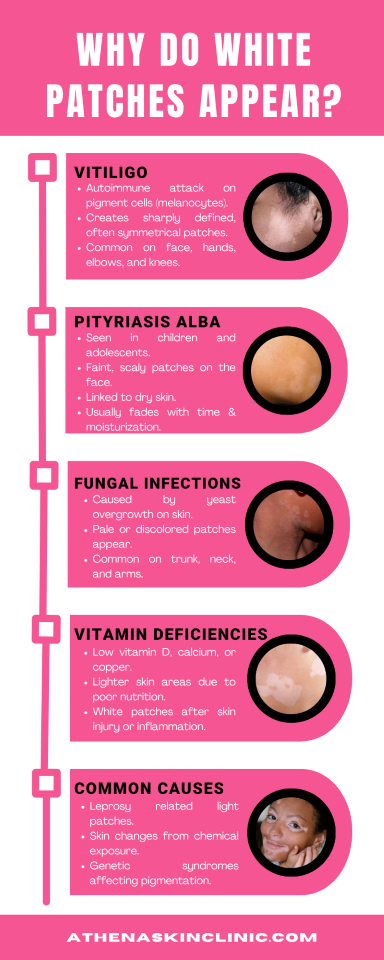Skin conditions often carry more than just a physical impact; they can affect self-esteem and social confidence too. Among these concerns, the appearance of white patches on the skin is one of the most common reasons people seek dermatological advice.
At Athena Skin Clinic, we regularly meet patients who are anxious about these patches, uncertain of their cause, and eager to find the right treatment.
White patches occur when an area of the skin loses its normal pigmentation and appears lighter than the surrounding surface.
While some causes are relatively harmless and temporary, others may require long-term care.
Understanding why these patches form is the first step toward managing them effectively.
Why Do White Patches Appear?
One of the most well-known causes of white patches is vitiligo, an autoimmune condition where the body’s immune system mistakenly destroys melanocytes, the cells responsible for producing melanin.
This results in sharply defined, often symmetrical patches that may gradually spread. Vitiligo can affect any part of the body, but the face, hands, elbows, and knees are common sites.
Children and adolescents often experience a condition known as pityriasis alba, which shows up as faint, scaly patches on the face. Unlike vitiligo, this is usually linked to dry skin and mild eczema, and tends to fade with time and moisturization.
Another frequent culprit is fungal infection, particularly tinea versicolor, caused by an overgrowth of yeast that naturally lives on the skin.
This leads to pale or discolored patches on the trunk, neck, or arms, especially in hot and humid conditions.
Nutritional deficiencies may also play a role. Low levels of certain vitamins and minerals, including vitamin D, calcium, and copper, sometimes manifest as lighter skin areas. In other cases, white patches appear after the healing of skin injuries or inflammations — a phenomenon called post-inflammatory hypopigmentation.
Though less common, conditions such as leprosy, chemical exposures, or genetic syndromes can also present with light patches.
Book Your Skin Consultation with Dr. Harmandeep Sidhu
Trusted dermatologist in Chandigarh. Get expert care in skin, hair and lasers at Athena Skin Clinic.

Risk Factors and Triggers
Several factors can make individuals more prone to developing white patches.
A family history of vitiligo or other autoimmune conditions increases the risk, as does living in environments that are hot and humid, which encourage fungal growth.
Poor nutrition, excessive sun exposure without adequate protection, or a weakened immune system can further heighten susceptibility.
Treatment and Management
The good news is that most white patches can be treated effectively once the underlying cause is identified.
At Athena Skin Clinic, treatment begins with a careful diagnosis, often involving a skin examination and sometimes laboratory tests.
Depending on the condition, treatment may include antifungal creams or oral medications for infections, moisturizing and gentle skin care for pityriasis alba, or specialized therapies such as topical steroids, calcineurin inhibitors, and phototherapy for vitiligo.
Nutritional counseling can also play an important role when deficiencies are involved. For stubborn cases, advanced procedures like laser therapy or even skin grafting may be considered.
When to Seek Help?
While not every white patch is a sign of a serious disorder, it’s important not to ignore persistent or spreading changes.
If the patches are accompanied by itching, scaling, numbness, or discomfort, or if they appear suddenly and expand quickly, consulting a dermatologist is strongly recommended.
Early diagnosis not only helps in effective treatment but also in preventing complications.
A Final Word
White patches on the skin can be unsettling, but they are not uncommon. From harmless conditions that resolve on their own to autoimmune disorders that require long-term care, the spectrum is wide.
The most important step is to seek professional advice rather than relying on guesswork or home remedies.
At Athena Skin Clinic, our focus is on combining expertise with compassion, ensuring that every patient receives the right diagnosis and personalized care to restore both skin health and confidence.

